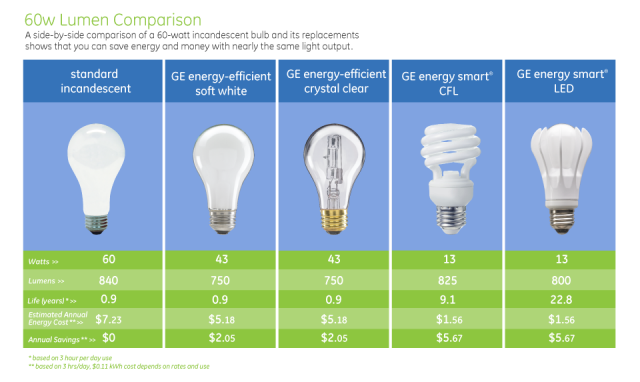Incandescent Bulb vs CFL Bulb vs LED Bulb Part II
Light Bulb Comparison
Let’s examine the three most popular light bulb options: Incandescent, Compact Fluorescent and LED. We will look at the advantages and disadvantages, starting with Incandescent.
Incandescent Light Bulb
An incandescent light bulb or lamp is an electric light which produces light with a wire filament heated to a high temperature by an electric current passing through it, until it glows. The hot filament is protected from oxidation with a glass bulb that is filled with inert gas. The light bulb is supplied with electric current by terminals or wires embedded in the glass. Most bulbs are used in a socket which provides mechanical support and electrical connections.
Incandescent bulbs are manufactured in a wide range of sizes, light output, and voltage ratings, from 1.5 volts to about 300 volts. They require no external regulating equipment, have low manufacturing costs, and work equally well on either alternating current or direct current. As a result, the incandescent lamp is widely used in household and commercial lighting, for portable lighting such as table lamps, car headlamps, and flashlights, and for decorative, holiday and advertising lighting.
Incandescent bulbs are much less efficient than most other types of electric lighting; incandescent bulbs convert less than 5% of the energy they use into visible light, with standard light bulbs averaging about 2.2%. The remaining energy is converted into heat. The luminous efficacy of a typical incandescent bulb is 16 lumens per watt, compared with 60 lm/W for a compact fluorescent bulb or 150 lm/W for some white LED lamps. Incandescent bulbs typically have short lifetimes compared with other types of lighting; around 1,000 hours for home light bulbs versus typically 10,000 hours for compact fluorescents and 30,000 hours for lighting LEDs.
Incandescent bulbs are gradually being replaced in many applications by other types of electric light, such as fluorescent lamps, compact fluorescent lamps (CFL), cold cathode fluorescent lamps (CCFL), high-intensity discharge lamps, and light-emitting diode lamps (LED). Some jurisdictions, such as the European Union, China, Canada and United States, are in the process of phasing out the use of incandescent light bulbs while others, including Colombia,[6]Mexico, Cuba, Argentina, Brazil or Australia,[7] have prohibited them already.
CFLs: Compact Fluorescent Lights
According to EnergyStar.gov, CFLs work differently than incandescent bulbs in that, instead of running an electric current through a wire filament, they drive an electric current through a tube that contains argon and mercury vapor. This process creates ultraviolet light that quickly translates into visible light, unlike incandescent lights which put off a warm glow.
The big difference between CFLs and incandescent bulbs is how much energy it takes to use them over time. CFLs use about 70% less energy than incandescent bulbs. They also last years longer than traditional bulbs, and only cost about a dollar more per bulb.
However, one of the biggest drawbacks of CFLs is that it takes a few moments for them to warm up and reach full brightness. That means they’re not ideal in spots where you want lots of light as soon as you flip the switch, such as a dark, steep basement stairway. They also cannot be used with a dimmer switch.
Plus, modern CFLs contain a small amount of mercury, which is very harmful to both your health and the environment. That means it’s bad news to break one (here’s how to clean it up safely if you do), and they shouldn’t be disposed of in your regular household trash (here’s how to recycle them).
LEDs: Light-Emitting Diodes
Light-emitting diodes, or LEDs, were for years most commonly found in small electronic displays, such as the clock on your cable box. Because the light emitted by each tiny LED is directional and fairly weak, household LED bulbs were on the fringe of mainstream technology just a few years ago.
According to the Lighting Research Center, LED light bulbs work by bringing together currents with a positive and negative charge to create energy released in the form of light. The result is a fast source of light that is reliable, instantaneous, and able to be dimmed.
What sets LEDs apart from incandescent bulbs and CFLs is just how long they can last.According to Consumer Reports, LED light bulbs can last anywhere from 20,000 to 50,000 hours, or up to five times longer than any comparable bulb on the market.
But that combination of efficiency and durability has historically come at a cost. LEDs cost more money than CFLs and incandescent bulbs. The good news, however, is that their price has dropped considerably over the years.
Where once it was common to pay $50 or even $100 for an LED light bulb, they’re now available for about $8 a bulb on Amazon. IKEA sells its own 60W-equivalent LED light bulbs for just $5, and Home Depot is reportedly running a promotion in May that will discount Philips LED light bulbs to as low as $2.50 per bulb.
Despite concerns over mercury content and contamination issues, policy makers, manufacturers, and scientists are in agreement over the greater environmental and economic benefits of CFLs. When recycled properly, nearly every component of a fluorescent bulb can be separated and reused – even the mercury.
According to the EPA, electricity from coal-fired power plants is the main source of U.S. mercury emissions. By using CFL bulbs in place of incandescent, we can decrease the demand for coal-fired power and in doing so, significantly reduce the amount of mercury released into the environment.



